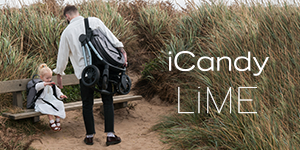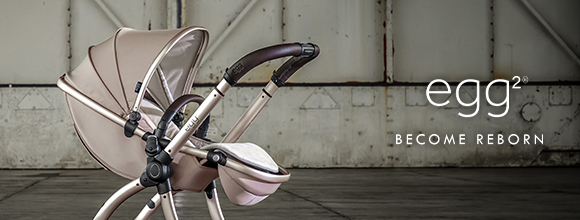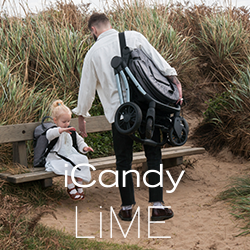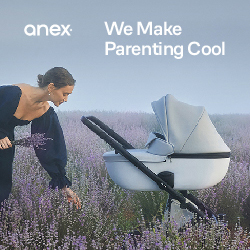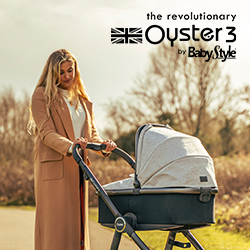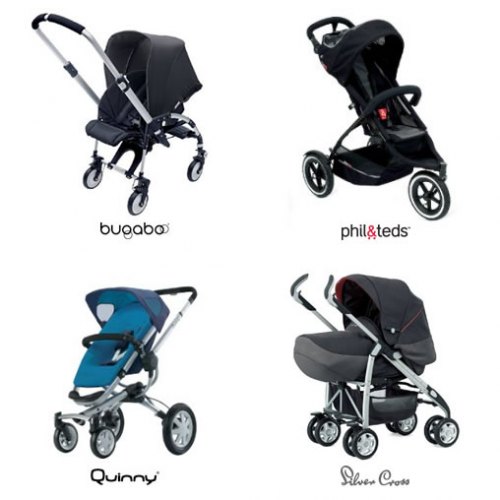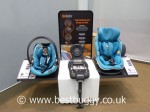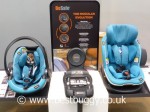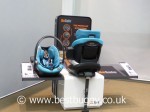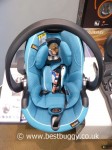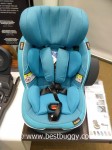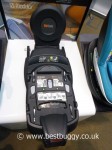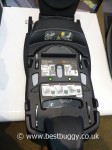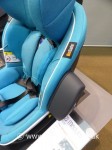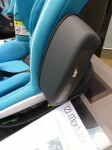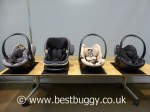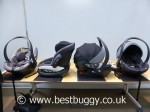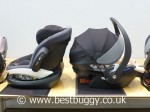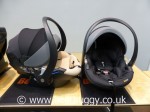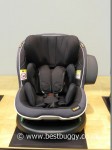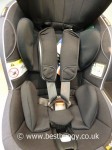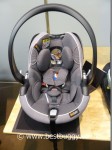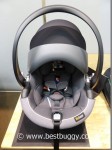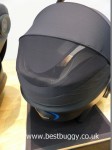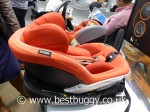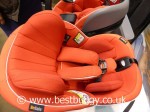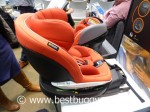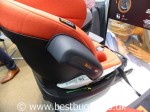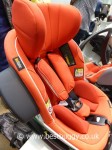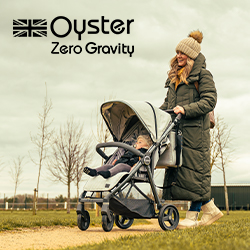BeSafe iZi Modular & Visit to TRL Child Safety Centre
The Best Buggy team were kindly invited by BeSafe to attend the launch of their BeSafe iZi Modular system. The launch took place at TRL (Transport Research Laboratory) in Berkshire, which houses a Child Safety Centre, where car seats and infant carriers are safety tested and certified, as meeting the relevant safety standards.
The BeSafe iZi Modular System is a three in one system – an isofix base; an infant carrier and a toddler car seat (6 months plus) which can rear or forward face until the child is 105cms tall – approx age 4.
The BeSafe iZi Go Modular infant carrier is i-Size. It is certified for use with a baby from 40 cm to 75 cm (approx 12 months). However, new i-Size regulations mean that if an i-Size seat is used, then the baby must rear face until 15 months of age. Thus the progression into the toddler seat allows the child to remain rear facing until they reach 15 months of age. At this point the child in the toddler seat can forward face – or they can remain rear facing up to the maximum height of the seat (105 cm) – but there is this option to turn the child forward facing after 15 months if the parents wish.
The unique selling points of the BeSafe iZi Modular are:
1. High spec interior – There were comfort pads everywhere to ensure maximum comfort for the child. There is an extra thick head rest cushion with hollow centre which was really cool and unique. There were thick memory foam body hugging side walls on the infant carrier. It all looked very comfortable and plush. We did feel that the harness pads were very thick for a young baby, and also we had concerns that the side pieces of the 5 point harness could be easily misrouted around the removable base seat pad. We, and a retailer, all puzzled over fitting this pad correctly even though it was actually very simple. Given the pad moves, a parent would need to check the routing every journey before putting the baby in.
2. Side Impact Protection – Both car seats had a movable block which you put on either the left or right of the seat, and which is designed to reduce the space between the seat and the door. This acts as a shock absorber and reduces the space that the car seat can accelerate into in the event of an impact. We loved this idea especially for the toddler seat. However, you are likely to remove this SIP block from the infant carrier each time you remove the seat from the car as it does look a little odd e.g. when using the seat on a pushchair chassis for example. Our concerns were that this block would easily be misplaced. We hope BeSafe do spares!
3. Amazing recline on the toddler seat. It was noted that on other brands, there is no transition for a baby from being newborn into a toddler seat. Babies still need to be reclined to sleep (ideally laid flat). Be Safe have given their toddler seat a very deep recline when rear facing. This combined with all the extra padding makes the transition for a child from infant carrier to toddler seat easier. There is also a recline when the seat is forward facing. Although the toddler seat is suitable from 6 months, we would recommend that you leave your little one in the iZi Go Modular infant carrier until the absolute maximum, and then move the child, rear facing into the toddler seat at the height of 75cm. An infant carrier is built specifically for a baby, whereas a convertible toddler seat is more of a compromise.
4. Unique adjustable base / leg room – the base slides about 8cms to give an older toddler more leg room which is a really good idea, and answers the critics who say that a child’s legs are getting squashed when rear facing. We thought even so that the base looked a little uncomfortable for a child to rest their legs and feet on – there’s several bumps rather than being flat. But a child may well not be bothered.
5. Five Point Harness - Be Safe didn’t list the 5 point harness as a unique selling point, but very few infant carriers have a 5 point harness. If this works well, then it is a good selling point. However, we would need to see a baby in the seat to see how well it fits.
The ISOFIX base looks really complicated, however, it is very easy to install. There are 2 buttons to pull the ISOFIX arms out, and one button to disconnect the seat. We absolutely loved the indicators and an audible beep, which ensured that the base was fitted correctly. When used with the toddler seat, there is a front brace which must be fitted.
There were some very beautiful colours including a gorgeous turquoise blue, However, it was a little disappointing to find that BeSafe charge extra for certain colours! The black infant carrier has an RRP for £180 whereas the Melange has an RRP of £200.
BeSafe have a promotion on at some retailers to give away free car seat adaptors for a pushchair when you buy the iZi Go Modular system – so it is worth asking about this if you plan to buy the infant carrier with a pushchair from an independent retailer. Representatives from Joolz, Bumbleride and Mima were present to see the new products. The BeSafe seats fit onto these travel systems amongst many others using the universal, often called ‘Maxi-cosi’ adaptors.
i-Size
It is clear that there is still confusion about i-Size. For the manufacturer, perhaps the most significant part of i-Size is that the car seats have side impact protection, which as a consumer felt a little strange to hear, because the message coming through is that a child should stay rear facing until at least 15 months old. It is not mandatory for seats to fit using ISOFIX although manaufacturers are encouraged to ensure that seats are easy to correctly install. Height of the child is also key, and will be the measure by which a parent decides which car seat is appropriate for their child.
TRL
TRL – Transport Research Laboratory – is a huge place. If you Google map TRL you will see that they have test tracks and roads all marked out behind the buildings. They test all sorts of things – not just car seats – but trains, items connected to cycling, walking etc. They work closely with Good Egg Safety to get messages across to parents about child safety.
TRL are non profit making and invest everything back into the company. They said that car seat crash safety testing was very competitive. An average car seat needs around 15 sled runs before passing safety standards. Any tweaks mean that it takes more than this. Doing thirty crash tests is not unusual to gain certification for sale.
The representative from TRL talked about i-Size. There are currently three phases to i-Size.
Phase 1 – has been in force since July 2013. This phase was to ensure infant carriers have integral isofix (before 9 months old).
Phase 2 – under development – is looking at booster seats. Ensuring that i-size / specific vehicle boosters are able to prevent undesirable occupant behaviour e.g. abdomen protection. Also to improve compatibility like in Phase 1. Isofix will be optional. Not all cars have isofix. This has to be completed by Sept 2017
Phase 3 – Requires further definition around the future of R44 i.e. whether it will be phased out or whether it will remain as a safety standard.
The TRL rep discussed the effect of child mass on CRS performance. i-Size specifies a maximum occupant mass: 33kg – this is made up of the seat and child weight (including clothing and shoes). There is no requirement for seats to be tested with this maximum mass of occupant. So a company can ‘make this up’ i.e. 33kgs minus seat weight equals….X
However, TRL have done their own independent testing on this with the Q3 dummy – a 50th centile average 3 year old one, a 75th centile one, and a 99th centile one, and in an ERF seat they could clearly see that as the mass increased, the child slid up the seat upon impact. So there were increased head excursions if the isofix anchorage was overloaded.
The biggest issue with car seats is incorrect fitting. Parents don’t fit the car seat in using the car seat belt tightly enough, and then on top of that don’t secure the child in firmly enough. BOTH of these need to be tight! We discussed how important it is to fit the car as per the car seat manufacturers instructions. The BeSafe Modular system has a brace on the ISOFIX base, but in some cars, seats need to brace against the back of the seat in front, or against the dashboard. We were not sure this message was getting across to parents.
The TRL lady then took us into the crash test laboratory. This white, clinical room had two parts. The first was the control room from where the tests were done and monitored. The second larger area was the sled and pulley / track. The track was at a guess, about 20 metres long. Down the side ran big bunches of elasticated cord – like bungey rope. If I remember correctly there were 12 cords, but only 8 were used for car seat testing.
Car seats only have to pass testing at 70kph or 43mph. The tests can in theory go higher, but if the sled accelerates too fast, then the dummy moves position; and it is important that the dummy stays in position in the seat. They use full capacity ropes for Formula 1 cars! The sled stops in front of a solid wall. Two prongs enter tubes on the wall which absorb the energy.
The sled gets rotated round for Side Impact Protection (SIP) testing. This SIP was pretty impressive! They put metal tubes into the wall which are around 3-4 metres long, and they crumple down to literally about 30cms long! It is unbelievable to see how these huge tubes end up so tiny!
Whilst we were in the room, the sled was being prepared with a dummy on. The dummies are Q dummies. They have Q dummies in different sizes. These have sensors all over their bodies, and include new abdominal sensors to check for possible internal injury. The sensors all come together in a massive bundle of cables!
At the very end we had a chat to the TRL lady about what we had seen and about car seats, and we got to ask her our burning questions!
Interestingly, it seems that really only TRL and ADAC do independent testing in Europe – TRL have just helped set up a lab in China, but ADAC is the BIG name. ADAC test car seats to higher speeds. What was a real shock, was that ADAC sell their findings to ALL the people we believe are independent testers – to Which? to Oamtec, to ADAC etc. No one else does their own testing!!!! So whatever results that ADAC give a car seat, these should be reflected in the other organisations ‘results’. The lady did say that ADAC is the gold standard.
The lady also said that price does not always mean a seat is better. Some cheap seats do surprisingly well in testing. However, it also does not mean that cheap seats are better than a main brand either!
We discussed ERF seats and if she felt they were safer. You could tell she was uncomfortable with giving an opinion on this, but she pretty much agreed that it depends where you plan to be hit as to which car seat is best. We discussed the research she had talked about during her presentation where the heavier 99th centile child slid upwards out of the ERF seat. This correlates with some information we were told some time ago, about ERF being best for under 2 year olds.
We asked about the use of add-on chest clips. It is against the law to add on a chest clip to a Group 1 car seat except to a seat made specifically for a child with Special Needs. Apparently, there is provision for a chest clip to be added to a seat and tested under i-Size regulations, but to date no car seats have be submitted for testing with a chest clip added. Chest clips should still not be added after a car seat has been tested.
We talked too about booster cushions, and how the .gov website on car seats, is rather surprisingly, not actually car seat law. However car seat Groups e.g. Group 0+ and Group 1 or Group 3 etc., ARE law. So although the .gov website says a child should be 22kgs to use a booster cushion, in fact, a booster cushion is fine to use from 15kg because it is a Group 2/3 seat. TRL are part of a campaign to try to get booster cushions used only for children over 125 cm.
The TRL lady was fascinating and we left with a zillion more questions to ask her.
Thank you very much to BeSafe for inviting us, and to them, and the lovely lady at TRL for their talks and information. We had a very interesting and informative day.
- Kiddy Cruiserfix 3 Review by Best Buggy
- Recaro Zero. 1 Elite Car Seat
- Jané Matrix Light Review
- Child Car Seats - Real Life v's Theory.
- Cozy 'n' Safe Excalibur v's Apramo One v's Diono Radian 5
- Maxi-Cosi Rodifix Air Review by Best Buggy
- Mifold - the Grab-and-Go Booster Cushion
- Finding the Right Car Seat for a Child with Additional Needs
- Juniair Go Booster Inflatable Child Car Seat
- BeSafe iZi Modular & Visit to TRL Child Safety Centre
- Mifold Booster Cushion Car Seat
- CasualPlay Q-Retraktor Review by Best Buggy
- Cosatto Zoomi Review by Best Buggy
- Cosatto Hootle Review by Best Buggy
- Cosatto Hug Review by Best Buggy
- Kiddy Evo-lunafix Review by Best Buggy
- The Introduction of the 2015 i-Size Car Seat Regulation
- Maxi Cosi Axiss Fit Review - Submitted to Best Buggy
- Best Buggy's Car Seat Safety Tips and Advice
- Why Babies Should Travel Laid Flat In A Car Seat Infant Carrier.
- Simple Parenting Doona Car Seat Stroller Review by Best Buggy
